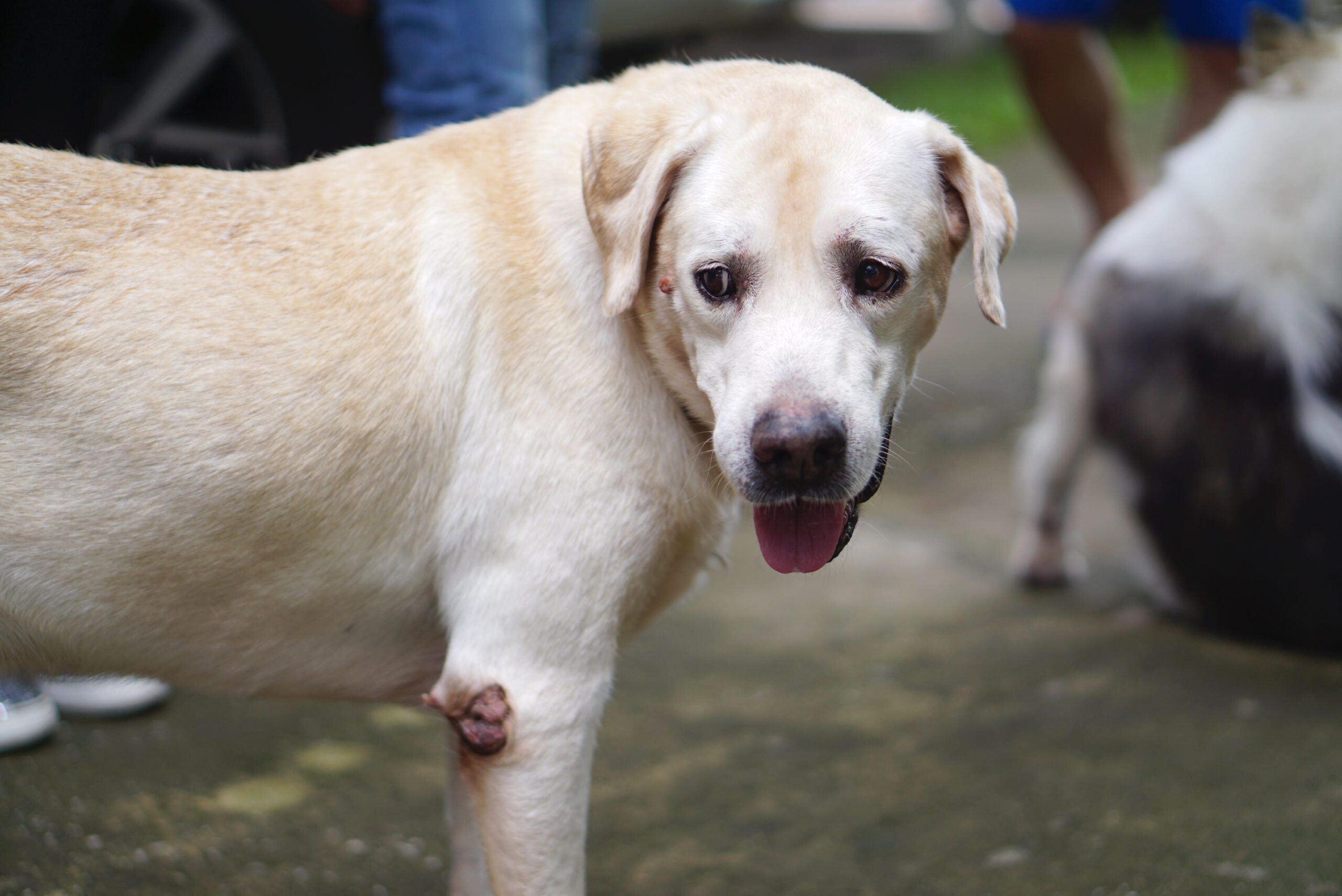Key Points:
- Dog warts are small skin growths typically found on a young dog’s lips, eyelids, paws, or inside their mouth and throat.
- These warts are caused by canine papillomavirus (CPV1), a contagious virus that affects dogs through direct contact, like sniffing, licking, or sharing a water bowl with an infected dog.
- Any dog can develop dog warts, but these papillomas almost always form on dogs younger than two years old since their immune systems have not properly developed.
Have you noticed an abnormal skin growth on your pup’s paw? Or how about a red bump on their snout? It could be a wart.
Warts on dogs, also known as papillomas, are small skin growths typically found on a dog’s lips and inside their mouth — and sometimes on their eyelids, paws, or in their throat. While dog warts often look nasty, especially oral papillomas, they’re rarely a serious threat to your dog’s health. Still, papillomas are common among younger dogs, and these benign growths can lead to secondary infections if they become inflamed or infected.
No one wants to find unexpected warts, growths, or lumps on their dog’s skin. Here, we outline everything pet parents need to know about dog warts, including detection, treatment, and prevention.
What do dog warts look like?
Dog warts are typically easy to spot. These lesions tend to resemble a small brain or head of cauliflower (gross, we know), are dark in color, and can be round, oval, or irregularly shaped. They can grow up to three centimeters in length. Directly attached to your dog’s skin, they appear suddenly and sometimes form in clusters. They tend to resemble large skin tags in humans.

According to Dr Linda Simon, MVB MRCVS, a veterinary surgeon and writer with Senior Tail Waggers, dog warts don’t cause pain or discomfort. “However, if the papilloma snags on something, it can bleed and become infected,” she says. “Until it heals, this will cause some irritation to your dog.” If a wart forms on an area prone to friction, it may break open and bleed. If a wart forms inside your pup’s mouth, they may develop bad breath and have trouble eating, breathing, or swallowing.
Finally, your dog may also pass on warts to other dogs. So, while they usually clear up on their own, some pet parents choose to have them removed.
What causes warts on dogs?
Canine papillomavirus (CPV1) is a highly contagious virus that affects dogs through direct contact, like sniffing, licking, or sharing a water bowl, with another infected dog. CPV1 can enter the body through a break in the skin, such as cuts, or the soft, moist skin (mucus membranes) found inside a dog’s mouth. The virus can also be transmitted through tick, flea, or mosquito bites.
Once the virus has entered its host (the dog), it has an incubation period of up to two months before symptoms appear. When papillomas form, they rapidly increase in size over the course of several weeks.
Any dog can develop this common canine skin problem, but papilloma’s almost always form on dogs younger than two years old since their immune systems have not fully developed. Older dogs have matured immune systems that can fight off CPV1 before it leads to physical skin abnormalities. Dog warts are more common in dogs who spend a lot of time around other dogs. They can also occur in immunosuppressed pups. Some dog breeds are even at an increased risk of developing warts, such as Cocker Spaniels, Miniature Schnauzers, Pugs, and Shar-Peis.
As soon as a dog has become infected with CPV1, they become contagious to other dogs, but not other animals or people. “Warts are very common in dogs and shouldn’t cause pet parents any alarm,” says Dr. Simon.
In one study, a CPV1 outbreak at a doggy daycare led to 13 out of 52 dogs developing warts.
How veterinarians diagnose dog warts
Your veterinarian will likely diagnose your pup with warts based on their physical appearance. On the off chance that the diagnosis isn’t clear, they may order a fine needle aspiration. This is when a small amount of fluid or tissue is suctioned from the growth with a needle and syringe to be examined under a microscope. Your veterinarian will search for any cell changes or abnormalities. In severe cases, your veterinarian may order a biopsy to remove a piece or the entirety of the growth and examine it microscopically.
How do I get rid of canine warts?
Most cases of dog warts don’t require a trip to the vet, but it’s still a good idea to keep an eye on them. Unless they become irritated, infected, or cause discomfort, dog warts typically don’t require medical treatment. Most of the time, papillomas regress on their own after 6 to 8 weeks as the immune system learns to fight the virus.
If your dog does need medical intervention, one surgical removal option involves crushing warts with a surgical tool to stimulate an immune response to fight CPV1. Your dog will be sedated during this procedure, and their warts will typically heal within a few weeks. Other dog wart removal options involve removing the lesions with a scalpel or even freezing them, but these are only for rare cases.
Recovery and care
It’s extremely important to prevent your dog from licking, scratching, itching, or biting the papillomas on their skin. Any sort of contact can cause inflammation, infection, bleeding, and further discomfort. If your pup gets surgery, keep the incision site clean. Try to prevent your dog from picking at it, too.
Prevention
Dogs contract canine warts through contact with another infected dog — whether that’s at the dog park, doggy daycare, or even at home from their pet sibling. Ultimately, the only preventative measure against canine warts is keeping your dog away from infected dogs. Give their bedding, toys, food, and water bowls a good wash, and consider staying away from other dogs for a few weeks as the lesions heal.
The bottom line
It’s normal for pet parents to worry when they spot a mysterious growth on their dog’s skin – but with dog warts, you can rest assured that your pup isn’t in any harm. Warts on dogs are extremely common in young pups and generally heal on their own. With proper recovery and care, your dog will be back to normal and running around the dog park in no time.
As your dog grows up, they will occasionally suffer from accidents or illnesses. And when your dog faces an unexpected health problem, Pumpkin dog insurance plans can help you afford the care they need. Worry less about your wallet and more about getting the best possible care for your pooch.
FAQs: Dog warts
- https://seniortailwaggers.com/pictures-of-dog-warts/
- https://www.kingsdale.com/oral-papillomas-and-warts-in-dogs#:~:text=They%20can%20range%20from%20small,and%20around%20the%20oral%20cavity.
- https://www.merckvetmanual.com/digestive-system/diseases-of-the-mouth-in-small-animals/papillomas-in-dogs
- https://firstvet.com/us/articles/papilloma-virus-in-dogs-and-cats
- https://pmc.ncbi.nlm.nih.gov/articles/PMC5479657/




